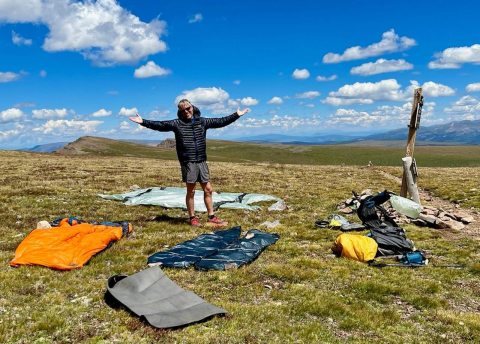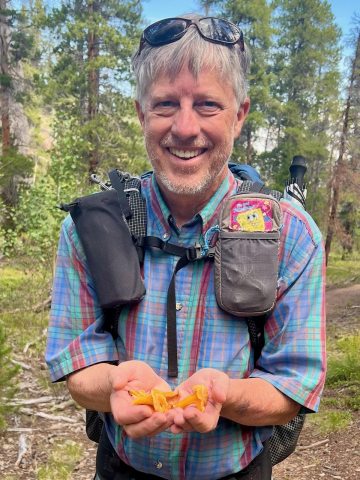Wilderness health tips

Are you planning a hike this fall? Keep these tips in mind to stay healthy and safe.
Fall can be a great time in the Pacific Northwest to enjoy nature before winter sets in.
If you’re planning to head out for an adventure, as you prepare, be sure to take note of key supplies and tips to help you stay healthy and safe on your outing.
PeaceHealth has many healthcare providers who are very active and versed in the outdoors, perhaps none more so than Eric Stark, MD, a family medicine physician at PeaceHealth in Burlington and Sedro-Woolley, Washington.
Before beginning his medical practice, Dr. Stark was a professional ski patroller and river and fishing guide. His personal outings have included every kind of terrain, including rivers, oceans, mountains and trails up to 2,500 miles with some trips lasting more than six months.
First and foremost, follow tried-and-true rules for spending time in the great outdoors — whether you’re a novice or more experienced. These include:
- Pack the 10 essentials.
- Go with at least one other person. And always let others know where you’re going and when you expect to be back.
- Make sure your footwear is right for your plans; bring an extra pair of socks if the trail conditions could be wet.
- Wear sunscreen to prevent sunburn, which can happen even when the weather is cloudy.
- Make sure you wear and have adequate clothing for changing weather conditions.
First aid and medications
Dr. Stark recommends tailoring what you carry in your first aid kit to where you are going and how long you’ll be out.
Day hikes: Carry a basic first aid kit with adhesive bandages, antibiotic ointment, ibuprofen for pain relief and an antihistamine like cetirizine to relieve allergy symptoms such as watery eyes, runny nose, itching eyes/nose, sneezing, hives, and itching. People with certain health conditions or who have the possibility of a bad allergic reaction should also carry whatever their doctor has prescribed such as an epinephrine pen or prednisone.
Multi-day hikes (2-6 days): For longer hikes, add to your basic first aid kit some larger gauze dressings (such as Telfa and paper tape for holding dressings in place.

Dr. Stark also recommends carrying an antidiarrheal (such as Imodium) and something for nausea like ondansetron to at least be able to control nausea and diarrhea to prevent dehydration in case of illness.
Long trips (1 week or more): For long trips and more remote areas ask your primary care provider about antibiotics suitable to your destination and potential risks. For instance, international travel antibiotics for traveler's diarrhea would be appropriate for some areas. And for long remote trips, antibiotics could be appropriate for skin infections, bladder infections or pneumonia.
Communication
Cell phone service can now reach many trail areas. However, it’s good to have a back-up means of communication in case of emergency, especially for long trips.
Several new devices on the market allow two-way texting communication as opposed to a simple one-way beacon. Having the two-way communication will help in case you need to decide if an emergency evacuation is needed, he notes.
If you’ll be out for more than a few hours, be sure to pack extra batteries, a solar charger or other means of keeping the device powered.
Plan for “what ifs”
“I suggest considering ‘what if’ situations,” Dr. Stark says. “A hike in a remote area on a warm summer day can get scary if someone breaks an ankle and has to spend a cold night out.”

If nights are expected to be cold, be sure at least one member in your group is carrying extra clothing or even a lightweight sleeping bag to share.
“I also make sure to always carry at least one headlamp, a lighter or matches and a little extra food,” he says.
Trail encounters
During Dr. Stark’s last three-week trek in the Colorado mountains, he and his hiking companion encountered everything from pikas, marmot, deer, elk, moose, a bear and “angry squirrels.” Don’t assume the smaller animals are harmless. It’s best to keep your distance from critters — for your sake and theirs.
They also found wild raspberries and chanterelle mushrooms to supplement their meals along the way; however, he does NOT recommend eating foraged foods along the trail unless you are confident it’s safe.

Do your homework and talk with people who know the area so you can plan accordingly. Depending on where you’re going, you could require additional supplies, such as tarps, rope or bear spray. One particularly helpful, and stylish, piece of equipment is a lightweight umbrella for longer walks on hot summer days or extended periods in rain.
Be alert
No matter where you are, pay close attention to your surroundings. Hazardous changes in the weather — high wind, rain, hail and lightning — can come up suddenly. You’ll want to watch for signs of change and take cover, if necessary.
Above all, know your limits and play it safe. If you’re new or out of practice, don’t overdo it or go beyond your current skills or fitness level. Get used to carrying a pack or hiking on rough ground little by little.
From childhood, Dr. Stark has been roaming backwoods and mountainsides so his instincts for making the most of outdoor adventures are finely honed. But he insists that anyone can get out and enjoy Mother Nature.
Day trips are fine. And while your local park might not be considered “wilderness,” being out in it can provide you much-needed relief from everyday stress.
“Long hiking trips make me feel alive again. It feeds my soul,” he says.
Getting out in the woods or on a trail is a great way to exercise your body and renew your spirit. Just take precautions to do it safely.





